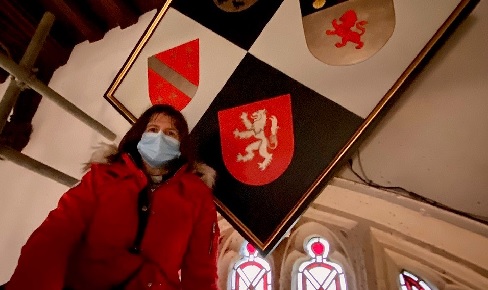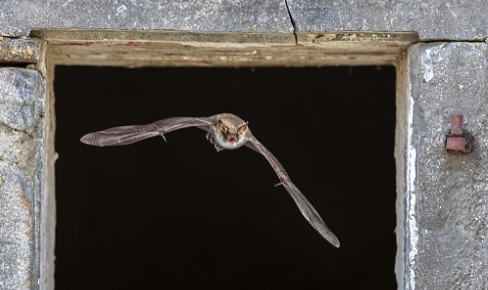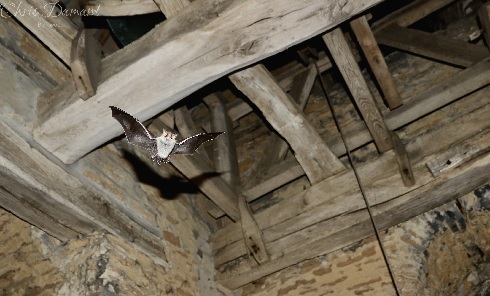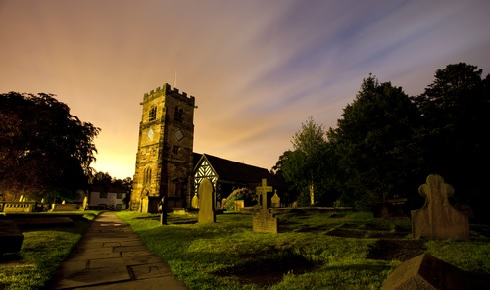On a wing and a prayer
It is thought up to 70% of rural UK churches contain bat roosts. Ione Fitzpatrick explains how the Bats in Churches project is helping to protect these nocturnal congregations and their homes
May 31st 2021
In the village of Peakirk, just outside Peterborough, lies the beautiful 11th-century church of St Pega. This Grade I listed building is home to a series of rare 14th-century wall paintings, including an unusual warning to church gossips, where two women in medieval dress are having their heads pressed together by a devil. The church is home to more than just ancient artwork, though: it also has a 300-strong maternity colony of soprano pipistrelle bats (Pipistrellus pygmaeus). As of 2018 the bats were regularly flying through the interior of the church, leaving droppings and urine all over the pews and startling churchgoers.
St Pega is just one of thousands of UK churches facing similar issues. In small numbers, bats often go unnoticed, but when they roost in large numbers a conflict arises between the wildlife, the church community and the priceless artefacts housed inside. Some data suggests around 70% of rural churches in England contain bat roosts, although in some areas it could be as high as 90%.
In the Holy Trinity Collegiate Church in Tattershall, Lincolnshire, 600 soprano pipistrelle bats swoop and swirl around the grand medieval church most summer evenings, before slipping through a small gap above a heavy Gothic door and out into the countryside to forage. This is in addition to a colony of approximately 200 Daubenton’s bats (Myotis daubentonii) that have been using the church for decades.
Unlike residential and commercial buildings, where bats and people are separated by a ceiling, churches usually have an open roof architecture. Droppings and urine fall directly onto surfaces in the main building, and the bats take to the naves and the aisles to socialise or learn to fly. All exposed surfaces must be cleaned up before each event and the mess can stain walls and damage culturally important items[1]. Such is the burden of cleaning, which often falls on volunteers, the bat droppings have even caused some churches to close.
Bats have been around for around 50 million years, long before humans graced the plains of Africa let alone conceived of and constructed churches. Originally bats made use of nooks in caves and trees to roost, but with the clearing of woodland for agriculture and housing in England many of these opportunities have been lost.
Looking through the lens of a roosting bat, it’s easy to see why aging churches – peppered with holes and gaps in the stone or stained glass – became a tempting prospect. Much like a woodland, they provide a cavernous but sheltered canopy under which bats can sleep, fly and socialise. Cooler areas such as crypts provide spaces for hibernation while warmer areas, such as the timber beams under south-facing roofs, are ideal for maternity colonies.
The Bats in Churches project was born out of the need to protect the valuable heritage housed in our nation’s oldest buildings while continuing to protect bat populations. To create harmony between these twin figureheads of the rural landscape, it was essential to provide church communities with workable solutions that enable them to use their buildings as intended while celebrating, rather than lamenting, the presence of bats.
The project has been able to pursue its difficult task thanks to the creation of Natural England’s Bats in Churches Class Licence. This gives highly trained ecologists the flexibility to get creative in their bat mitigation solutions. A grant totalling £4.5m (£3.8m coming from the National Lottery Heritage Fund and the project partners making up the rest) covers the costs of the project over five years (2018-2023) and the project partners - Natural England, the Church of England, the Bat Conservation Trust, the Churches Conservation Trust and Historic England – have agreed to make their shared vision a reality.

In 2012–2014 the University of Bristol carried out research into Natterer’s bats (
Myotis nattereri) in historic churches, and found bats are very loyal to their church roosts and to their foraging areas, suggesting that they could be slow to find new roosts if displaced. Population modelling indicated that excluding the bats from the church would have a detrimental effect on their welfare and conservation status. However, the study did have some success in trialling the use of deterrents, such as high-intensity ultrasound, to humanely move the roosts within the churches to prevent accumulations of droppings and urine in sensitive areas[
2].
The study suggested that deterrents are likely to be most effective in the spring, before the young are born and when Natterer’s bats are more transient. In most sites the bats moved away from the ultrasound noise and found other locations within the church to roost, and a majority continued to use the new roost site even after the acoustic deterrent was taken away. In stark contrast, the trialled use of artificial light as a deterrent was ended early because of welfare concerns.
The bats were reluctant to leave their roost at all, raising the potential of entombment and death from starvation. Overall the researchers were able to show that with careful regulation and close monitoring, the use of deterrents could be a useful tool for licensed ecologists.
While every church and its associated roost is unique and demands a bespoke solution, the plans being trialled by the Bats in Churches project are often based around creating alternative roosting sites with enclosed flight spaces, so that the bats can enter and exit their roosts without flying around the main body of the church or roosting over sensitive items. The solution is then put in place temporarily and, if the bats take to it, it is imposed permanently on the condition that it is monitored for several years to ensure the population remains healthy.
When much of the lead roofing was stolen from the roof of St Pega’s in 2018 it put both the rare wall paintings and the pipistrelles at risk. However, it also provided an opportunity to re-roof the church in a way that helped keep the business of the daytime and nighttime congregations separate. A survey of the roost in the summer of 2019 found a 300-strong roost still in residence, safely within an enclosed section of the roof, and they will continue to be monitored for several more years.
St Lawrence’s Church in Willington, Bedfordshire, is another example of this type of bat mitigation project being trialled through the collaboration of a highly skilled ecologist, church architect, local bat group and church community. By building a heated bat box disguised as a hatchment around their primary entry and exit point at the top of a stained glass window, bats are still roosting there in high numbers but are no longer able to access the interior of the church. The priceless artefacts inside are now protected from the damage that bat urine and droppings were causing and the community are once again able to use their church as intended without the hours of cleaning.

The plans at St Moran’s Church on Cornwall’s Roseland Peninsula are more elaborate, with the creation of two enclosed flight spaces on either side of the church and a tunnel between the two that acts as a fly-way for the bats to move between them. The church, which has been unofficially closed for several years, is now getting ready to open its doors again for community events.
It is thought that around 6,400 historic churches across the country contain bat roosts[
3], but this is an out-of-date estimate. It is likely to be many more and it varies across the country. In Norfolk, for example, anecdotal evidence from ecologists suggests that over 90% of churches house bat roosts. The Bats in Churches project is inviting members of the public to survey their local churches this summer for evidence of bats (no previous experience is necessary) to help provide a more accurate idea of how bats are using churches regionally and people’s attitudes towards them. This should help provide better support and advice for churches struggling to strike a balance between bat and baptism.
The volunteer-led Bats in Churches study has already thrown up some surprising results. In the first survey season a combination of sound analysis from a bat detector and DNA analysis of the droppings revealed grey long-eared bats (Plecotus austriacus), one of the UK’s rarest mammals, roosting in a church in Devon. Of the 115 churches in England that have been surveyed so far, evidence of bats was recorded at nearly 70%. To reach their target of 500 churches, the project is in need of volunteers for the remaining two summers that are left to complete the survey. More information on getting involved can be found on the links below.
A video of the Bats in Churches project at Willington, Bedfordshire, can be found at bit.ly/batsinchurches
Ione Fitzpatrick is communications officer for the Bats in Churches Project
References1) Hales, J. Bats in churches: objective assessment of associated damage mechanisms.
Archaeol. Int.
17, 94–108 (2014).
2) Zeale, M.
et al. Mitigating the impact of bats in historic churches: the response of Natterer’s Bats Myotis nattereri to artificial roosts and deterrence.
PLOS ONE 11(3), (2016).
3) Sargent, G. Bats in Churches Project. The Bat Conservation Trust (1995).






